Research on Takeover Safety of Intelligent Vehicles Based on Accident Scenarios in Real-Vehicle Testing
Abstract
Highlights
- Identified critical safety risks in intelligent vehicles during large-curvature curves and static obstacle scenarios, including lane departure and missed target detection;
- Quantified minimum driver reaction times for safe takeover: 4.12 s for longitudinal control and 1.87 s for lateral control.
- Emphasizes enhancing driver engagement during human-machine cooperative driving (HMCD) phases to reduce passive fatigue and improve emergency readiness;
- Proposes strengthening early warning systems in autonomous driving to ensure sufficient takeover time, addressing functional limitations in current driving automation systems.
Abstract
1. Introduction
1.1. Related Work
1.2. Problem Research
2. Materials and Methods
2.1. Research Methods
2.2. Typical Accident Scenarios
2.2.1. Curved-Road Accident Scenario
2.2.2. Static-Obstacle Accident Scenario
2.3. Real-Vehicle Testing Design
2.3.1. Test Scenario Setting
2.3.2. Preparation for the Experiment
2.3.3. Experiment Process
- (a)
- Lateral Control Scenario
- (b)
- Longitudinal Control Scenario
2.4. Data Recording
2.4.1. Lateral Control Scenario Through Principles
2.4.2. Longitudinal Control Scenario Through Principles
2.4.3. Driver Takeover Time Calculation
- (1)
- When the system issued a warning but did not actively respond, the driver took over vehicle control;
- (2)
- When no warning was issued, but the ACC function disengaged, the driver took over vehicle control;
- (3)
- When neither a warning was issued nor the ACC function disengaged, and the system failed to respond effectively to the target ahead, the driver took over control when the Time To Collision (TTC) was ≤2 s;
- (4)
- If the system responded effectively to the obstacle and continued to drive within the lane, the driver did not take over, and the system maintained control.
3. Results
3.1. Analysis of Lateral Control Capability Test Results
3.2. Analysis of Longitudinal Control Capability Test Results
4. Discussion
5. Conclusions
- In scenarios involving roads with large curvatures, such as urban roads and highway ramps, the lateral control capabilities of some driving automation systems are insufficient, potentially leading to sudden system deactivation and lane departure. Additionally, the test vehicles’ ability to suppress drift in the section of the curve with constant curvature is poor, resulting in large oscillation amplitudes within the curve and posing safety risks;
- In static irregular obstacle scenarios, some driving automation systems have perception limitations, potentially leading to missed target detection or failure to recognize targets, resulting in a lack of effective warnings and takeover prompts for the driver. This can cause the vehicle to fail to decelerate in time, increasing the risk of collision accidents;
- For Level 2 combined driving assistance systems and other human–machine co-driving stages, vehicle design should focus on enhancing driver engagement in driving tasks, ensuring the driver is fully involved and ready to take over in an emergency. For Level 3 conditional driving automation functions, the system’s early-warning capabilities should be strengthened to ensure the driver has enough time to take over. Research shows that the takeover request for longitudinal control requires at least 4.12 s for the driver to react in time, while the takeover request for lateral control requires at least 1.87 s.
Author Contributions
Funding
Institutional Review Board Statement
Informed Consent Statement
Data Availability Statement
Acknowledgments
Conflicts of Interest
References
- Feng, Z.X.; Li, J.Y.; Zhang, W.H.; You, Z.D. A reviewon driver’s perception of risk associated with autonomous driving under human-computer shared control. J. Transp. Inf. Saf. 2022, 40, 1–10. (In Chinese) [Google Scholar]
- Zhang, Z.Z.; Li, H.H.; Gong, W.J. Autonomous vehicle development: Current landscape and emerging trends (2023). In Annual Report On China’s Intelligent Internet Development (2024); Tang, W.H., Tang, S.H., Liu, Z.H., Eds.; Social Sciences Academic Press: Beijing, China, 2024; pp. 177–188. (In Chinese) [Google Scholar]
- Xiao, G.M.; Lee, J.Y.; Jiang, Q.S.; Huang, H.L.; Abdel-Aty, M.; Wang, L. Safety improvements by intelligent connected vehicle technologies: A meta-analysis considering market penetration rates. Accid. Anal. Prev. 2021, 159, 106234. [Google Scholar] [CrossRef]
- NTSB. Collision Between a Sport Utility Vehicle Operating with Partial Driving Automation and a Crash Attenuator; HWY18FH011; National Transportation Safety Board: Washington, DC, USA, 2018. Available online: https://www.ntsb.gov/investigations/pages/HWY18FH011.aspx (accessed on 13 March 2025).
- Parasuraman, R.; Riley, V. Humans and automation: Use, misuse, disuse, abuse. Hum. Factors 1997, 39, 230–253. [Google Scholar] [CrossRef]
- Liu, Q.C.; Liu, J.Q.; Zhao, J.Y.; Cai, Y.F.; Wang, H.; Chen, L.; Lv, C. Takeover Time Prediction for Conditionally Automated Driving Vehicles: Considering Mixed Traffic Flow Environment. IEEE Trans. Intell. Transp. Syst. 2025, 26, 7496–7508. [Google Scholar] [CrossRef]
- Lu, G.Q.; Chen, F.C.; Li, P.H.; Zhai, J.D.; Tan, H.T.; Zhao, P.Y. Effect of drivers’ acceptance level of car-following risk on the takeover performance. Automot. Eng. 2021, 43, 808–814. (In Chinese) [Google Scholar] [CrossRef]
- Ma, X.X.; Chen, F.; Zhang, L. Takeover-performance and takeover-risk evaluation under non-critical transition scenarios. China J. Highw. Transp. 2022, 35, 159–168. (In Chinese) [Google Scholar] [CrossRef]
- Wang, M.; Mehrotra, S.; Wong, N.; Parker, J.; Roberts, S.C.; Kim, W.; Romo, A.; Horrey, W.J. Human-Machine interfaces and vehicle automation: A review of the literature and recommendations for system design, feedback, and alerts. Transp. Res. Part F Traffic Psychol. Behav. 2024, 107, 549–561. [Google Scholar] [CrossRef]
- Yan, S.X. Research on Recognition and Ranging of Traffic Objects in Front of Intelligent Vehicles. Master’s Thesis, Jilin University, Changchun, China, 2022. (In Chinese). [Google Scholar]
- Niu, Y.F. Research on Deep Learning-Based Object Detection Algorithms for Intelligent Driving. Master’s Thesis, University of Electronic Science and Technology of China, Chengdu, China, 2025. (In Chinese). [Google Scholar]
- Hu, Y.; Yuan, Z.H.; Tu, X.G.; Liu, J.H.; Lei, X.; Wang, W.J. Improved SSD object detection algorithm based on contrastive learning. Infrared Technol. 2024, 46, 548–555. (In Chinese) [Google Scholar]
- Chen, Q. Research on LIDAR-Camera Based Perception Fusion and System Development and Vehicle Field Testing. Master’s Thesis, Jilin University, Changchun, China, 2023. (In Chinese). [Google Scholar]
- Qian, J.K.; Zhu, J. Research on obstacle detection of autonomous vehicles based on improved SSD. Sci. Technol. Innov. 2025, 12, 54–57. (In Chinese) [Google Scholar] [CrossRef]
- Liu, C.Q.; Wang, H.S.; Liu, C.J. Double mask R-CNN for pedestrian detection in a crowd. Mob. Inf. Syst. 2022, 2022, 4012252. [Google Scholar] [CrossRef]
- Fan, H.L.; Li, Y.F.; Wang, C.S.; Guo, R.; Chen, X.F.; Zhu, Y.L. Research on autonomous navigation system for unmanned vehicles based on multi-sensor fusion. Laser J. 2025, 46, 15–21. (In Chinese) [Google Scholar] [CrossRef]
- Zhu, D.L.; Xu, G.H.; Zhou, J.; Di, E.B.; Li, M.C. Object detection in complex road scenarios: Improved YOLOv4-Tiny algorithm. In Proceedings of the 2021 2nd Information Communication Technologies Conference (ICTC), Nanjing, China, 7–9 May 2021; pp. 75–80. [Google Scholar] [CrossRef]
- Wang, Y.; Tian, Y. Pedestrian detection model in complex enVironment based on improVed YOLOV5s. Microelectron. Comput. 2024, 41, 29–36. (In Chinese) [Google Scholar] [CrossRef]
- Zhang, T.; Liu, H.P.; Wang, W.J.; Wang, X.W. Virtual tools for testing autonomous driving: A survey and benchmark of simulators, datasets, and competitions. Electronics 2024, 13, 3486. [Google Scholar] [CrossRef]
- Liang, Y.H.; Zhang, H.J.; Liu, B.; Luo, X.; Hu, H.Y. Research on real vehicle test and analysis method of driver’s manipulation abilities during curve driving. Automob. Technol. 2022, 06, 47–54. (In Chinese) [Google Scholar] [CrossRef]
- Paula, D.; Bauder, M.; Pfeilschifter, C.; Petermeier, F.; Kubjatko, T.; Böhm, K.; Riener, A.; Schweiger, H.G. Impact of partially automated driving functions on forensic accident reconstruction: A simulator study on driver reaction behavior in the event of a malfunctioning system behavior. Sensors 2023, 23, 9785. [Google Scholar] [CrossRef]
- Zhu, S.Y.; Zhou, Z.X.; Wu, J.G.; Chen, Q.C.; Wang, H.; Yang, C.Y. The influence of highway longitudinal slope and driving experience on driver’s physiology and psychology. J. Chongqing Univ. Technol. Nat. Sci. 2025, 39, 238–244. (In Chinese) [Google Scholar]
- Xu, J.; Zhang, Y.; Dai, Z.H.; Li, F.; Chen, J. Vehicle trajectory oscillation characteristics and lane width control under human natural driving conditions. J. Automot. Saf. Energy 2022, 13, 718–728. (In Chinese) [Google Scholar]
- Zheng, Z.A.; Ye, Z.; Zheng, X. Intelligent vehicle lateral control strategy research based on feedforward + predictive LQR algorithm with GA optimisation and PID compensation. Sci. Rep. 2024, 14, 22317. [Google Scholar] [CrossRef] [PubMed]
- Zhuang, J.F.; Li, Z.J.; Ding, R.; Xiong, W.L.; Zhang, H.S.; Xu, J. Vehicles trajectory oscillation characteristics and passenger cars’ lane width for freeways. J. Transp. Syst. Eng. Inf. Technol. 2023, 23, 324–336. (In Chinese) [Google Scholar] [CrossRef]
- Yu, D.; Park, C.; Choi, H.; Kim, D.; Hwang, S. Takeover safety analysis with driver monitoring systems and driver–vehicle interfaces in highly automated vehicles. Appl. Sci. 2021, 11, 6685. [Google Scholar] [CrossRef]
- Eriksson, A.; Stanton, N.A. Takeover time in highly automated vehicles: Noncritical transitions to and from manual control. Hum. Factors 2017, 59, 689–705. [Google Scholar] [CrossRef]
- Zhang, B.; De Winter, J.; Varotto, S.; Happee, R.; Martens, M. Determinants of take-over time from automated driving: A meta-analysis of 129 studies. Transp. Res. Part F Traffic Psychol. Behav. 2019, 64, 285–307. [Google Scholar] [CrossRef]
- Gerber, M.A.; Schroeter, R.; Ho, B. A human factors perspective on how to keep SAE Level 3 conditional automated driving safe. Transp. Res. Interdiscip. Perspect. 2023, 22, 100959. [Google Scholar] [CrossRef]
- Lu, Z.; Zhang, B.; Feldhütter, A.; Happee, R.; Martens, M.; De Winter, J.C.F. Beyond mere take-over requests: The effects of monitoring requests on driver attention, take-over performance, and acceptance. Transp. Res. Part F Traffic Psychol. Behav. 2019, 63, 22–37. [Google Scholar] [CrossRef]
- Louw, T.; Kuo, J.; Romano, R.; Radhakrishnan, V.; Lenné, M.G.; Merat, N. Engaging in NDRTs affects drivers’ responses and glance patterns after silent automation failures. Transp. Res. Part F Traffic Psychol. Behav. 2019, 62, 870–882. [Google Scholar] [CrossRef]
- State Administration for Market Regulation; Tesla (Beijing) Co., Ltd.; Tesla (Shanghai) Co., Ltd. Have Initiated a Recall of Certain Imported and Domestically Produced Model 3 and Model Y Vehicles. Available online: https://www.samr.gov.cn/zw/zh/art/2023/art_2f4ff4717aec41e3af2e28739732d97d.html (accessed on 13 March 2025). (In Chinese)
- Tesla Inc. Safety Recall Report 23V-838: Recall of Certain Model S, Model X, Model 3, and Model Y Vehicles Equipped with Autosteer; 23V-838; Tesla Inc.: Austin, TX, USA, 2023. Available online: https://static.nhtsa.gov/odi/rcl/2023/RCLRPT-23V838-8276.PDF (accessed on 31 July 2024).
- Yang, W.D.; Wu, Z.Z.; Tang, J.J.; Liang, Y.Y. Assessing the Effects of Modalities of Takeover Request, Lead Time of Takeover Request, and Traffic Conditions on Takeover Performance in Conditionally Automated Driving. Sustainability 2023, 15, 7270. [Google Scholar] [CrossRef]
- Zhang, B.; Wilschut, E.S.; Willemsen, D.M.C.; Martens, M.H. Transitions to manual control from highly automated driving in non-critical truck platooning scenarios. Transp. Res. Part F Traffic Psychol. Behav. 2019, 64, 84–97. [Google Scholar] [CrossRef]
- Stocco, A.; Pulfer, B.; Tonella, P. Mind the Gap! A Study on the Transferability of Virtual Versus Physical-World Testing of Autonomous Driving Systems. IEEE Trans. Softw. Eng. 2023, 49, 1928–1940. [Google Scholar] [CrossRef]
- Tanshi, F.; Söffker, D. A quantitative model of takeover request time budget for conditionally automated driving. arXiv 2024, arXiv:2408.15682. [Google Scholar] [CrossRef]
- Liang, K.X.; Calvert, S.C.; van Lint, J.W.C. Towards safe and comfortable vehicle control transitions: A systematic review of takeover time, time budget, and takeover performance. arXiv 2025, arXiv:2507.22262. [Google Scholar] [CrossRef]
- MoralesAlvarez, W.; Sipele, O.; Léberon, R.; Tadjine, H.H.; Olaverri Monreal, C. Automated Driving: A Literature Review of the Take over Request in Conditional Automation. Electronics 2020, 9, 2087. [Google Scholar] [CrossRef]
- J3016_202104; Taxonomy and Definitions for Terms Related to Driving Automation Systems for On-Road Motor Vehicles. SAE International: Warrendale, PA, USA, 2021. Available online: https://www.sae.org/standards/content/j3016_202104/ (accessed on 6 August 2025).
- ISO 19206-1:2018; Road Vehicles—Test Devices for Target Vehicles—Part 1: Requirements for Passenger Vehicle 3D Targets. International Organization for Standardization: Geneva, Switzerland, 2018. Available online: https://www.iso.org/standard/63991.html (accessed on 6 August 2025).
- Tan, G.Q.; Chen, W.H.; Yang, J.; Tran, X.T.; Li, Z.G. Dual control for autonomous airborne source search with Nesterov accelerated gradient descent: Algorithm and performance analysis. Neurocomputing 2025, 630, 129729. [Google Scholar] [CrossRef]
- Hu, J.X.; Yan, P.Q.; Tan, G.Q. A two-layer optimal scheduling method for microgrids based on adaptive stochastic model predictive control. Meas. Sci. Technol. 2025, 36, 026208. [Google Scholar] [CrossRef]
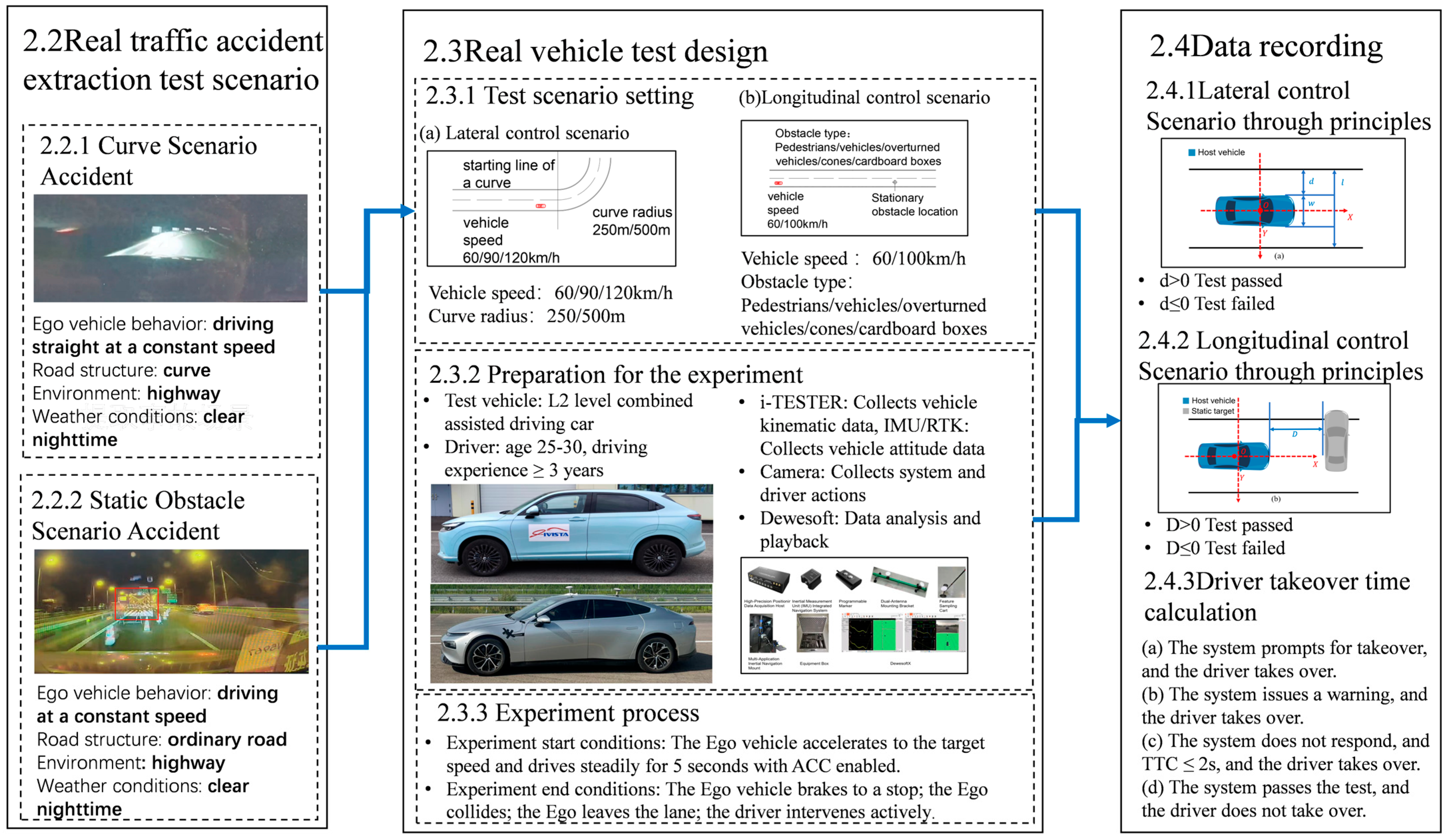
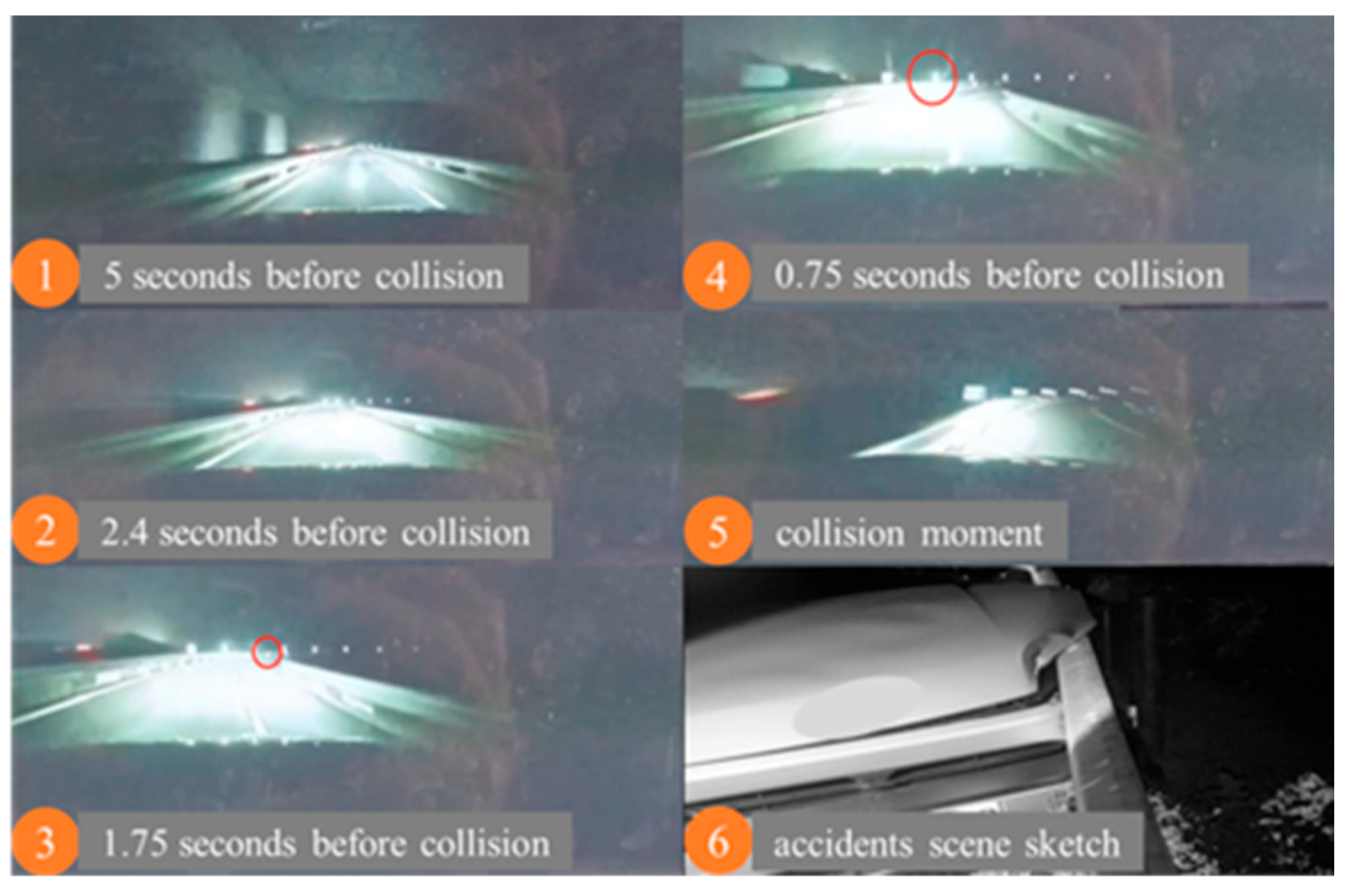
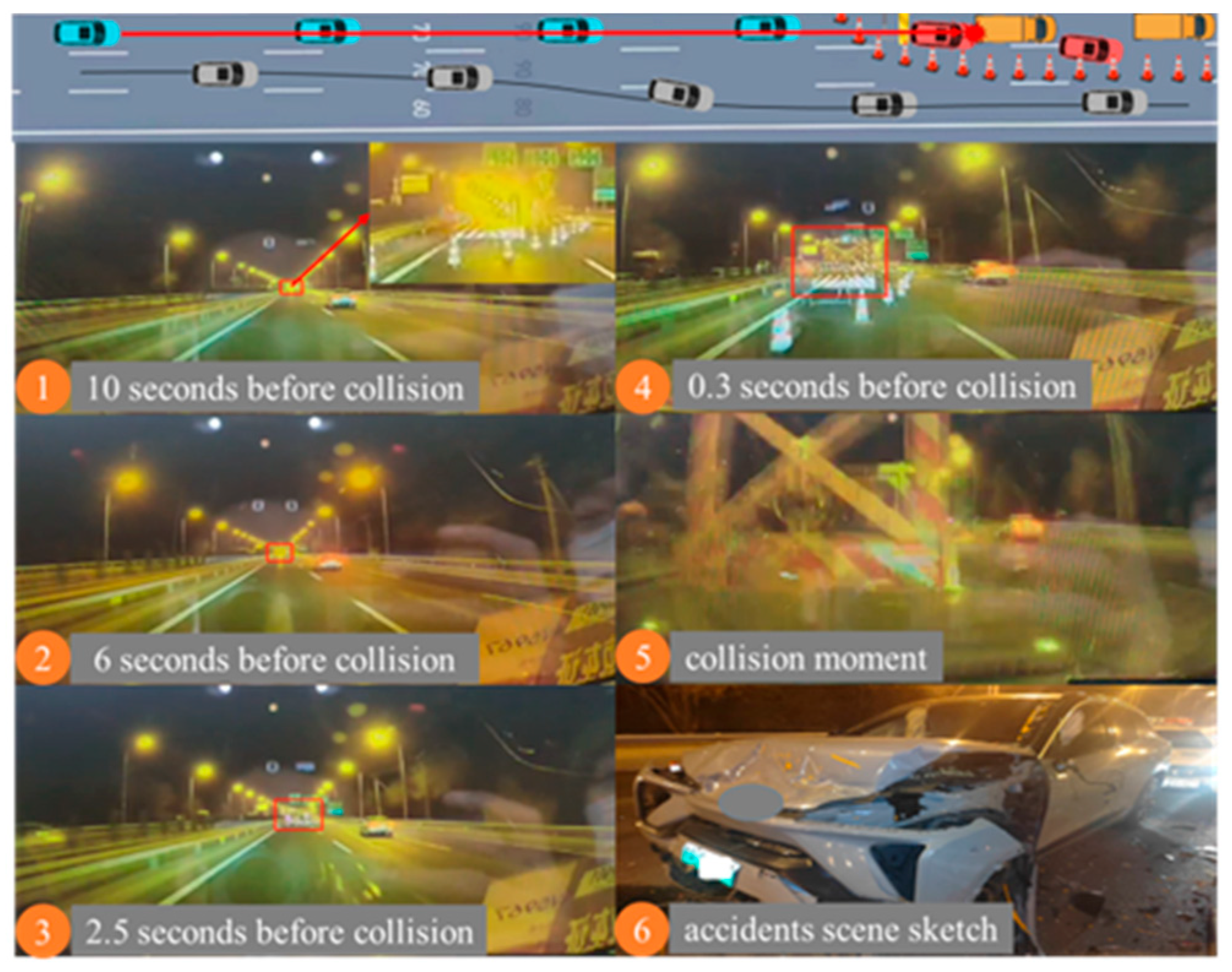

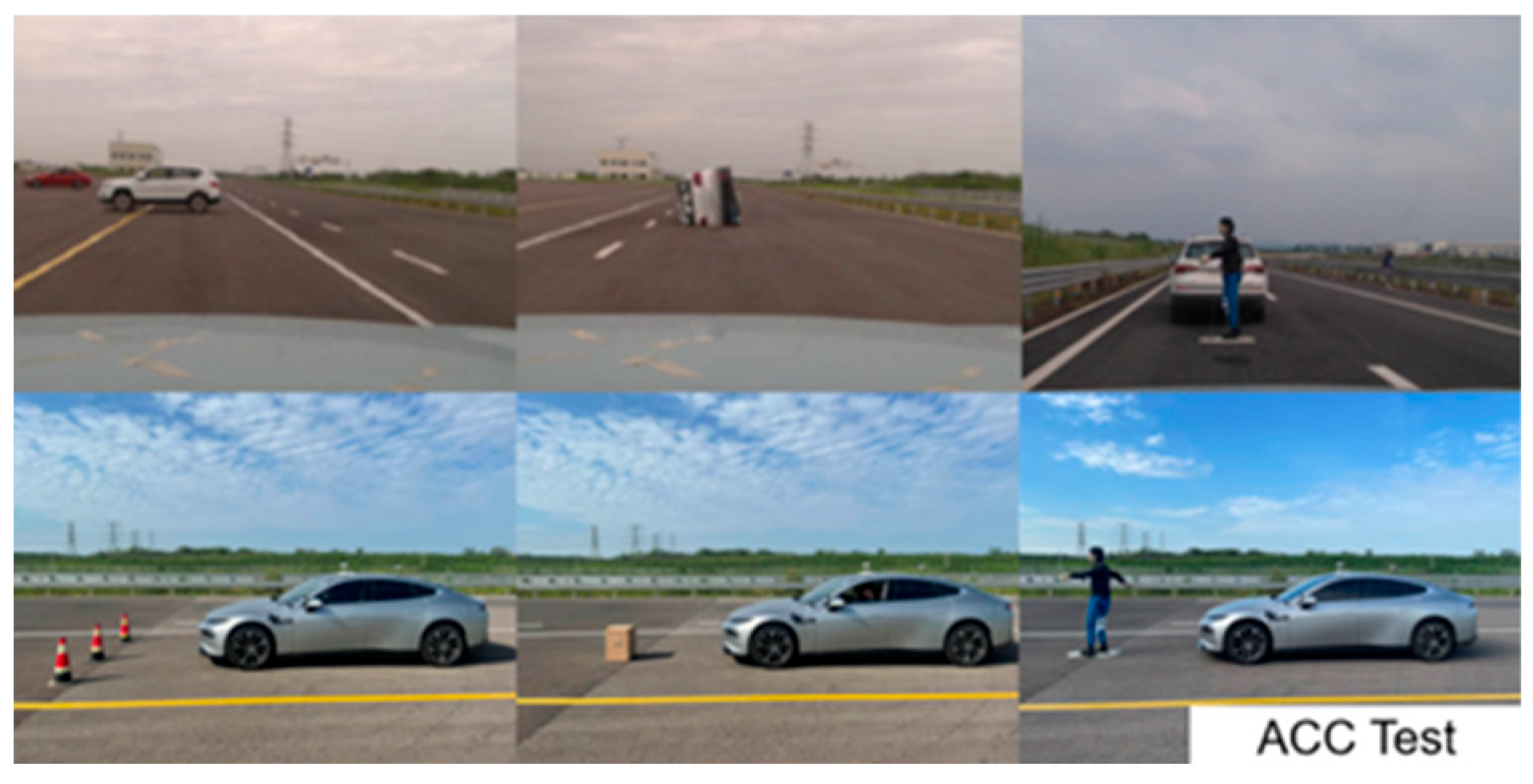
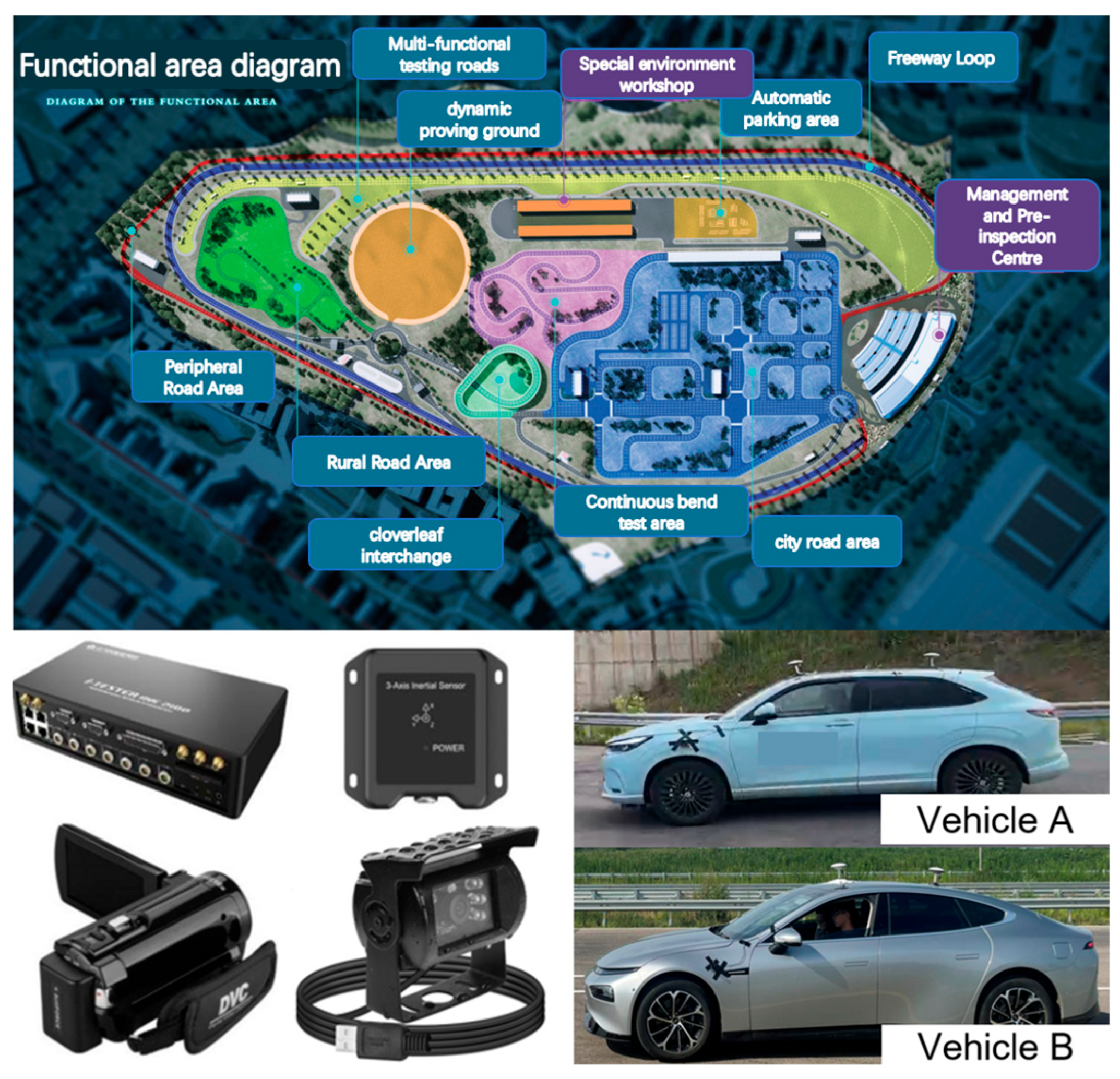

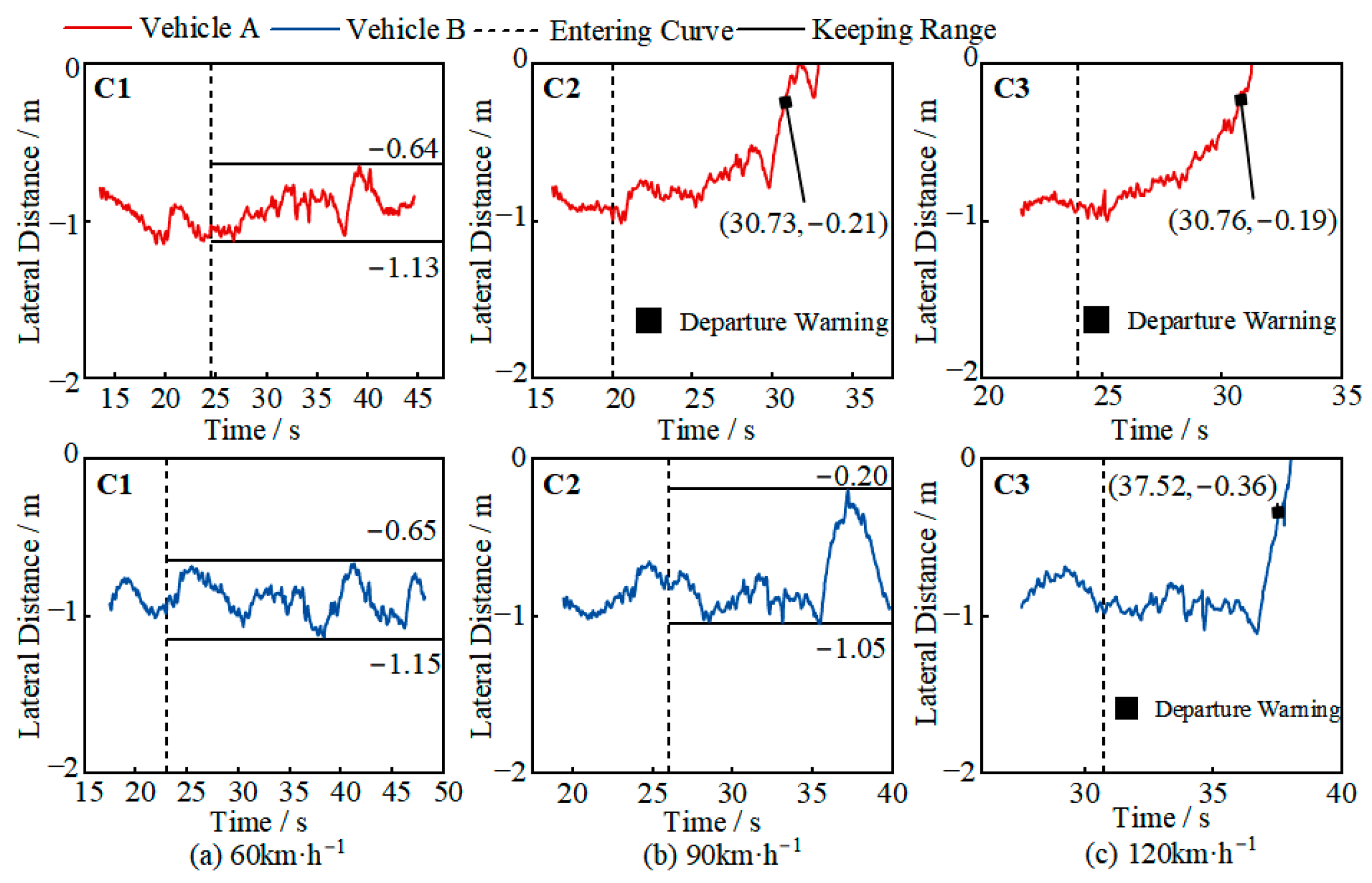
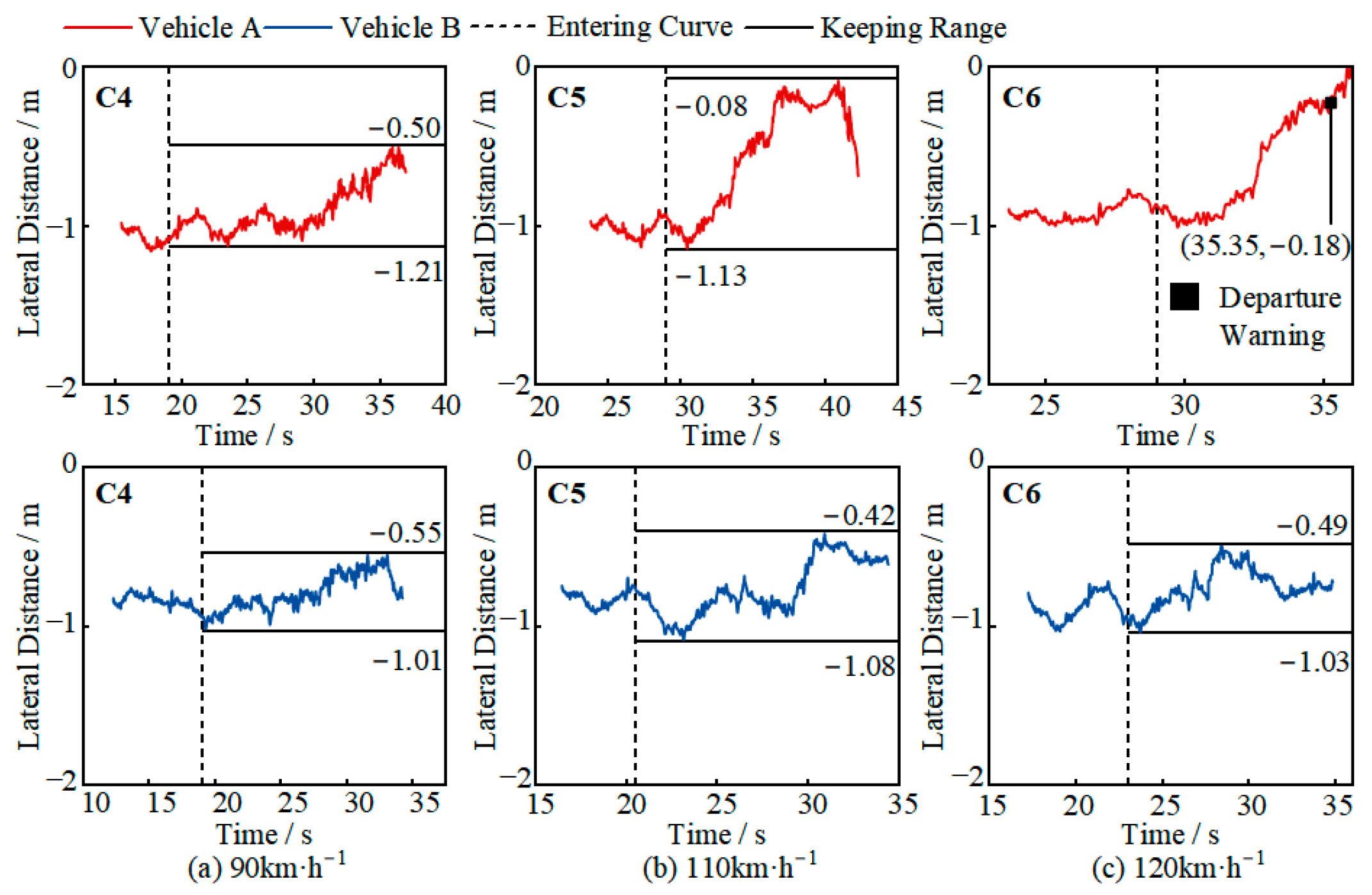

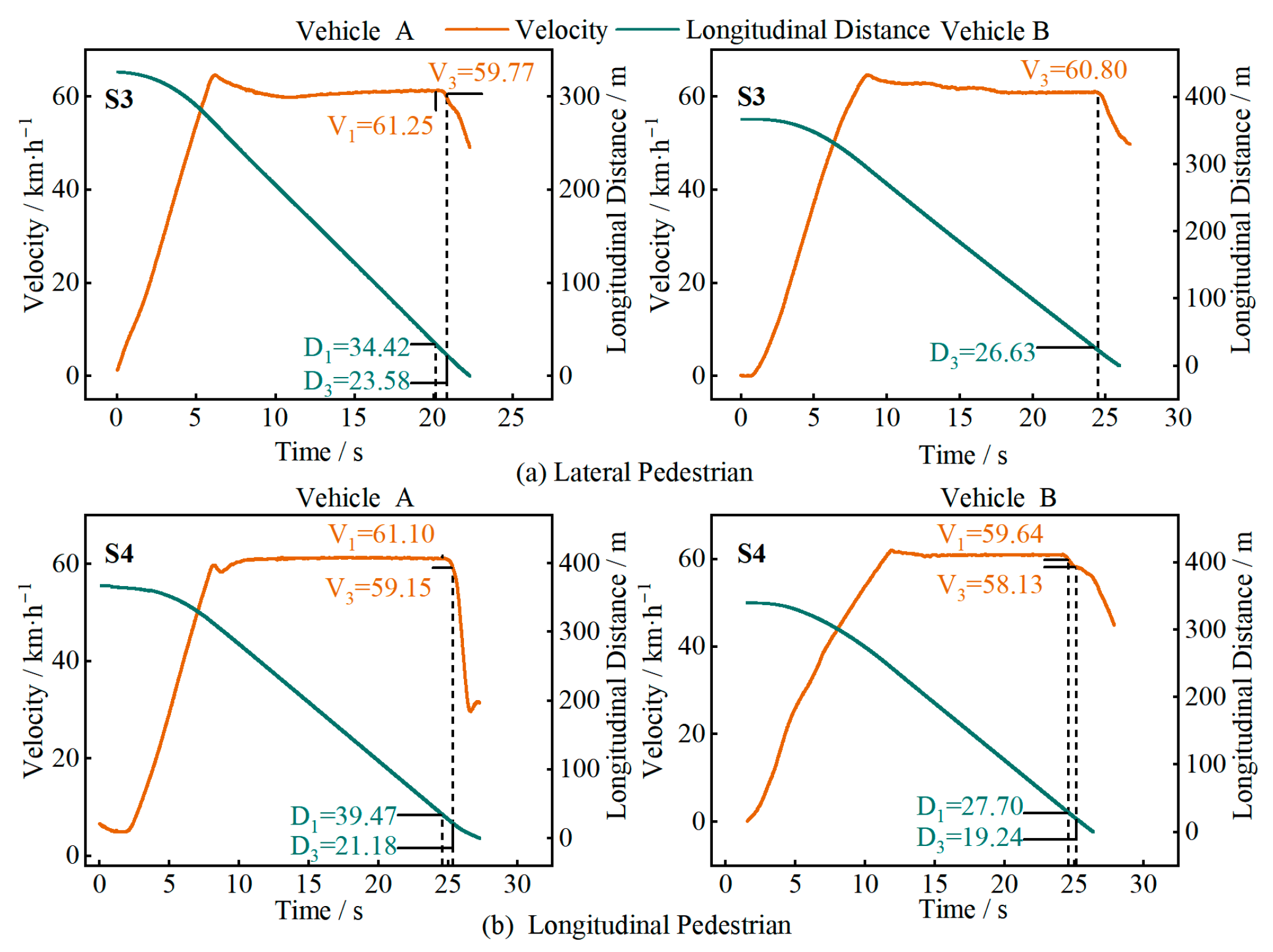



| Time (s) | NOA State | Speed (km/h) | Vehicle State | Remarks |
|---|---|---|---|---|
| −5 | Active | 111 | / | No warning or takeover prompt |
| −2.4 | Lateral control deactivated | 111 | / | |
| −1.75 | Fully deactivated | 111 | Lane departure | |
| −0.75 | / | 104 | Braking, steering | Driver takeover |
| 0 | / | 87 | Collision | Collision with guardrail |
| Time (s) | NOA State | Distance to Collision Target (m) | Remarks |
|---|---|---|---|
| −10 | Active | 250 | No warning or takeover |
| −7 | 174 | ||
| −3.69 | 62 | ||
| −1.49 | Deactivated | 7 | Driver takeover |
| 0 | Collision |
| Test Content | Test Scenario | Scenario ID |
|---|---|---|
| Lateral Control | Main vehicle at 60 km/h entering a 250 m radius right curve | C1 |
| Main vehicle at 90 km/h entering a 250 m radius right curve | C2 | |
| Main vehicle at 120 km/h entering a 250 m radius right curve | C3 | |
| Main vehicle at 90 km/h entering a 500 m radius right curve | C4 | |
| Main vehicle at 110 km/h entering a 500 m radius right curve | C5 | |
| Main vehicle at 120 km/h entering a 500 m radius right curve | C6 |
| Test Content | Test Scene | Scenario ID |
|---|---|---|
| Longitudinal control ability | Target: stationary vehicle, main vehicle speed 60 km/h | S1 |
| Target: overturned vehicle, main vehicle speed 60 km/h | S2 | |
| Target: stationary pedestrian crossing, main vehicle speed 60 km/h | S3 | |
| Target: stationary pedestrian along the road, main vehicle speed 60 km/h | S4 | |
| Target: stationary vehicle and pedestrian, main vehicle speed 60 km/h | S5 | |
| Target: stationary vehicle and pedestrian, main vehicle speed 100 km/h | S6 | |
| Target: traffic cone, main vehicle speed 60 km/h | S7 | |
| Target: cardboard box, main vehicle speed 60 km/h | S8 |
| Item | Vehicle A | Vehicle B |
|---|---|---|
| Sensor scheme | 12 ultrasonic radars 7 cameras 5 mm-wave radars | 12 ultrasonic radars 5 cameras 3 mm-wave radars |
| lateral control | Lane keeping assist system Lane deviation suppression system Lane offset reminder function | Adaptive curve cruise Lane center auxiliary Intelligent auxiliary lane change Lane departure warning |
| longitudinal control | Active cruise control system Collision mitigation braking system Front collision warning function | Forward collision warning Forward distance monitoring |
| Item | Test Vehicle A | Test Vehicle B |
|---|---|---|
| (m) | 1.790 | 1.896 |
| (m) | 0.665~1.145 | 0.612~1.092 |
| Scenario | Test Vehicle | (m) | (s) |
|---|---|---|---|
| C2 | A | 0.21 | 0.79 |
| C3 | A | 0.19 | 0.42 |
| B | 0.36 | 0.47 | |
| C6 | A | 0.18 | 0.48 |
| Scenario | Vehicle A | Vehicle B | ΔT (s) | |||
|---|---|---|---|---|---|---|
| (s) | (s) | (s) | (s) | Vehicle A | Vehicle B | |
| S1 | 2.85 | — | — | 1.61 | Stopped | Not recognized |
| S2 | — | 1.44 | — | 1.34 | Not recognized | Not recognized |
| S3 | 2.02 | 1.42 | — | 1.58 | 0.60 | Not recognized |
| S4 | 2.33 | 1.29 | 1.67 | 1.19 | 1.04 | 0.48 |
| S5 | 8.12 | — | 4.22 | — | Stopped | Stopped |
| S6 | 3.62 | 1.79 | — | 1.60 | 1.83 | Not recognized |
| S7 | — | 1.46 | — | 1.33 | Not recognized | Not recognized |
| S8 | — | 1.11 | — | 1.15 | Not recognized | Not recognized |
Disclaimer/Publisher’s Note: The statements, opinions and data contained in all publications are solely those of the individual author(s) and contributor(s) and not of MDPI and/or the editor(s). MDPI and/or the editor(s) disclaim responsibility for any injury to people or property resulting from any ideas, methods, instructions or products referred to in the content. |
© 2025 by the authors. Licensee MDPI, Basel, Switzerland. This article is an open access article distributed under the terms and conditions of the Creative Commons Attribution (CC BY) license (https://creativecommons.org/licenses/by/4.0/).
Share and Cite
Li, P.; Zhou, M.; Xu, C.; Li, H.; Hu, W.; Tan, Z.; Xiao, L.; Mou, X.; Feng, H. Research on Takeover Safety of Intelligent Vehicles Based on Accident Scenarios in Real-Vehicle Testing. Sensors 2025, 25, 5589. https://doi.org/10.3390/s25175589
Li P, Zhou M, Xu C, Li H, Hu W, Tan Z, Xiao L, Mou X, Feng H. Research on Takeover Safety of Intelligent Vehicles Based on Accident Scenarios in Real-Vehicle Testing. Sensors. 2025; 25(17):5589. https://doi.org/10.3390/s25175589
Chicago/Turabian StyleLi, Pingfei, Meiling Zhou, Chang Xu, He Li, Wenhao Hu, Zhengping Tan, Lingyun Xiao, Xiaojun Mou, and Hao Feng. 2025. "Research on Takeover Safety of Intelligent Vehicles Based on Accident Scenarios in Real-Vehicle Testing" Sensors 25, no. 17: 5589. https://doi.org/10.3390/s25175589
APA StyleLi, P., Zhou, M., Xu, C., Li, H., Hu, W., Tan, Z., Xiao, L., Mou, X., & Feng, H. (2025). Research on Takeover Safety of Intelligent Vehicles Based on Accident Scenarios in Real-Vehicle Testing. Sensors, 25(17), 5589. https://doi.org/10.3390/s25175589






